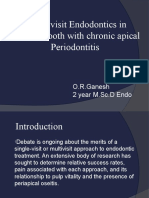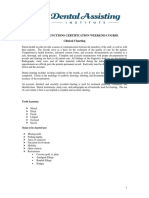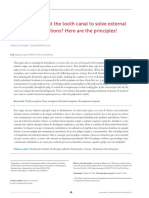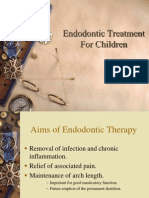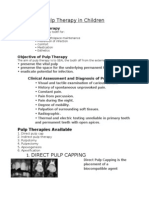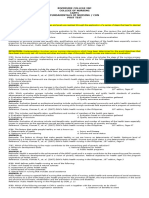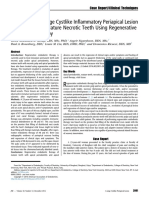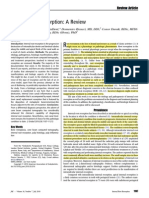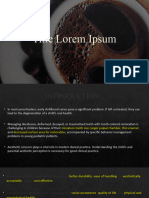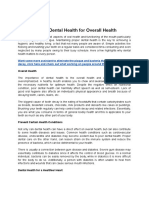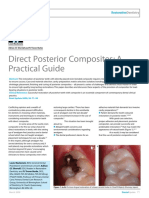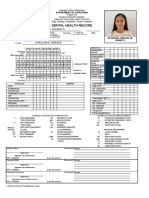0 ratings0% found this document useful (0 votes)
28 viewsChronic Fibrous Pulpitis Clinical Picture, Diagnosis, Endodontic Treatement
Chronic Fibrous Pulpitis Clinical Picture, Diagnosis, Endodontic Treatement
Uploaded by
Mouna Jomaa DhifaouiThis document discusses chronic fibrous pulpitis, including the clinical picture, diagnosis, and endodontic treatment. It describes the symptoms and presents two cases: one with an open pulp chamber and one with a closed pulp chamber. The objective examination findings are outlined. Treatment involves local pulp extirpation, which can be either vital or devital. The procedures for each are described in detail. Medications used for antisepsis, devitalization, and arsenic antidotes are also listed.
Copyright:
© All Rights Reserved
Available Formats
Download as PPTX, PDF, TXT or read online from Scribd
Chronic Fibrous Pulpitis Clinical Picture, Diagnosis, Endodontic Treatement
Chronic Fibrous Pulpitis Clinical Picture, Diagnosis, Endodontic Treatement
Uploaded by
Mouna Jomaa Dhifaoui0 ratings0% found this document useful (0 votes)
28 views11 pagesThis document discusses chronic fibrous pulpitis, including the clinical picture, diagnosis, and endodontic treatment. It describes the symptoms and presents two cases: one with an open pulp chamber and one with a closed pulp chamber. The objective examination findings are outlined. Treatment involves local pulp extirpation, which can be either vital or devital. The procedures for each are described in detail. Medications used for antisepsis, devitalization, and arsenic antidotes are also listed.
Original Title
chronic-pulpitis-Presentation
Copyright
© © All Rights Reserved
Available Formats
PPTX, PDF, TXT or read online from Scribd
Share this document
Did you find this document useful?
Is this content inappropriate?
This document discusses chronic fibrous pulpitis, including the clinical picture, diagnosis, and endodontic treatment. It describes the symptoms and presents two cases: one with an open pulp chamber and one with a closed pulp chamber. The objective examination findings are outlined. Treatment involves local pulp extirpation, which can be either vital or devital. The procedures for each are described in detail. Medications used for antisepsis, devitalization, and arsenic antidotes are also listed.
Copyright:
© All Rights Reserved
Available Formats
Download as PPTX, PDF, TXT or read online from Scribd
Download as pptx, pdf, or txt
0 ratings0% found this document useful (0 votes)
28 views11 pagesChronic Fibrous Pulpitis Clinical Picture, Diagnosis, Endodontic Treatement
Chronic Fibrous Pulpitis Clinical Picture, Diagnosis, Endodontic Treatement
Uploaded by
Mouna Jomaa DhifaouiThis document discusses chronic fibrous pulpitis, including the clinical picture, diagnosis, and endodontic treatment. It describes the symptoms and presents two cases: one with an open pulp chamber and one with a closed pulp chamber. The objective examination findings are outlined. Treatment involves local pulp extirpation, which can be either vital or devital. The procedures for each are described in detail. Medications used for antisepsis, devitalization, and arsenic antidotes are also listed.
Copyright:
© All Rights Reserved
Available Formats
Download as PPTX, PDF, TXT or read online from Scribd
Download as pptx, pdf, or txt
You are on page 1of 11
Chronic Fibrous Pulpitis ;
Clinical picture, Diagnosis ,
Endodontic treatement.
By ; Ahmed Eissa
Group ; 16LC1a
Chronic Fibrous pulpitis ;
1. pulpitis which takes place when the pulp chamber is open ;
Complaints: boring pain which appears from mechanical (rough food chewing), thermal (cold water) and
chemical irritants. The pain attack comes after cold water taking and slowly increases, it lasts for 15- 20
minutes. Sometimes pain appears when «suctioning» from the tooth and it goes away quickly. There is constant
heavy feeling in the tooth.
Medical history: The patient noticed acute spontaneous tooth pain around 7 months ago. The tooth hasn’t
been treated yet. Then acute spontaneous pain disappeared and the pain became causal and long lasting.
XRay Diagnosing: there is slight dilatation of periodontal fissure, its circuit is damaged. There is a connection
between carious cavity and pulp chamber in the area of dental pulp .
Conti..
Objective patient examination:
the examination discovered that the crown of the tooth has changed its color (dull, grey).
o There is deep carious cavity with wide inlet, the cavity floor is within the bounds of parapulpar dentin.
o Carious cavity walls dentin is dense and pigmented, it is soft on the floor.
o When probing there is a connection between carious cavity and pulp chamber discovered. The probing is sharply pain
ful in the place of connection, dental pulp is bleeding.
o Palpation of tunica mucosa of mouth from the side of oral cavity vestibule in the projection of causal tooth root apex i
s painless.
o Percussion of causal tooth is sensitive compared to contiguous teeth but painless.
o Thermodiagnosis is painful from cold water, the pain appears slowly, it becomes stronger step by step, and goes away
slowly after the irritant is gone.
o EPT ; is 30- 35 microampere.
Conti ..
2. pulpitis with closed pulp chamber ;
Complaints: boring, pulling tooth pain caused by mechanical irritants (when coarse food chewing), and boring pain
when cold water taking. The pain lasts for long time after the irritants are gone. There is pain which caused by
temperature change (when coming into warm room from cold air). There is also dull pain when cold air breathing in.
This pain lasts for long time. There is a carious cavity in a tooth, food gets stuck in carious cavity, heavy feeling in a
tooth.
Medical history: the tooth hasn’t been treated yet. The patient noticed acute spontaneous pain approximately 7 months
ago. The pain intensity decreased step by step and the pain was caused only by irritants (mechanical and thermal
ones) and environment temperature change.
Objective patient examination: there is deep carious cavity in a tooth with wide inlet in the area of parapulpar
dentin. Carious cavity walls dentin is pigmented, it is dense when probing. Carious cavity floor dentin is slightly
soft. Probing of carious cavity floor is sensitive (sometimes painful). Palpation is painless. Percussion (comparative)
is painless. Thermodiagnosis is painful for cold water. There is pain attack which doesn’t go away quickly. EOD is
30-35 microampere. X-Ray Diagnosing: there is slight dilatation of periodontal fissure in the area of root apex,
carious cavity which does not connect with pulp chamber.
Treatement ;
Treatment: Local: Pulp extirpation.
a)Vital extirpation;
b)Devital extirpation.
Extirpation of pulp ;
a) Vital extirpation:
-Antiseptic treatment of oral cavity; -Anesthetic treatment (infiltrate, field );
-Carious cavity preparation taking into account topographic and anatomic peculiarities of the tooth;
-Dental cavity opening;
-Coronal pulp removal (pulpotomy)
-Medical treatment of pulp stump;
-Stop the pulp stump bleeding; 46 -The
tooth canal orifices opening; -Root pulp extirpation (pulpectomy);
-Stop root canal bleeding;
-Tools and medical treatment of root canal(-s) of the whole length with using of endodontic tools of appropriate size;
-For medical treatment of root canals it is recommended to use nonirritating periodontium and fast-acting medical agents: antiseptic solutions:
halogens and oxidizers (1% sodium hydrochloride, 1% chlorhexidine solution, 1% iodinol solution, 3% hydrogen peroxide solution etc.);
quaternary ammonium compounds (0,5%-1% etoniy solution, 1% chloride benzalcone solution, 0,15% decamethoxine solution); phenol
compounds (5% phenol solution, 1% camphorparamonochlorophenol solution and its composite preparations), nitrofurans, antimicrobial agents
etc.;
-Root canal(-s) filling with material for root filling within the bounds of root apex opening;
-Carious cavity filling.
Devital extirpation ;
I patient’s visit ;
-Antiseptic treatment of oral cavity;
-Carious cavity preparation (opening and partial necrotomy of carious cavity) taking into account
topographic and anatomic peculiarities of the tooth;
-Pulp corn opening;
-Devitalizing paste input (arsenious, paraformaldehyde etc.);
-Carious cavity closing with occlusive dressing.
Conti ..
II patient’s visit ;
-Antiseptic treatment of oral cavity;
-Carious cavity preparation taking into account topographic and anatomic peculiarities of the tooth;
-Dental cavity opening;
-Coronal pulp removal (pulpotomy);
-Medical treatment of pulp stump;
-Stop the pulp stump bleeding;
-The tooth canal orifices opening;
-Root pulp extirpation (pulpectomy);
-Stop root canal bleeding;
-Tools and medical treatment of root canal(-s) of the whole length with using of endodontic tools of appropriate size;
-For medical treatment of root canals it is recommended to use nonirritating periodontium and fast-acting medical agents: antiseptic solutions: halogens and
oxidizers (1% sodium hydrochloride, 1% chlorhexidine solution, 1% iodinol solution, 3% hydrogen peroxide solution etc.); quaternary ammonium compounds
(0,5%-1% etoniy solution, 1% chloride benzalcone solution, 0,15% decamethoxine solution); phenol compounds (5% phenol solution, 1%
camphorparamonochlorophenol solution and its composite preparations), nitrofurans, antimicrobial agents etc.;
-Root canal(-s) filling with material for root filling within the bounds of root apex opening;
-Carious cavity filling. .
If it is necessary – restoration of crown of tooth with cements, compomers, composite materials, silver amalgam etc .. depending on topographic and anatomic
peculiarities of the tooth. It is possible to make prolonged filling when the cavity is closed with temporary filling.
Medications ;
1. Medications used for antiseptic treatment of carious cavities and root canals ;
Rp.: Sol. Hydrogenii perozydi dilutae 3% 50 ml
D.S. For carious cavity treatment.
Rp.: Sol. Chloramini 2% 30 ml
D.S. For carious cavity treatment .
Rp.: Chlorhexidini 0,06% 50ml
D.S. For carious cavity treatment when there are deep caries and pulpitis.
Rp.: Sol. Furacilini 0,02% 20 ml
D.S. For carious cavity treatment when there is caries.
2. Medications for necrotizing of dental pulp ;
Rp.: Flidi arsenicosi anhydrici
Dicaini aa 2,0
Ol. Camfphorae q.s.
M.f. pasta
D.S. For dental pulp devitalization.
Rp.: Paraformaldehydi 3,0
Novocaini 0,03
Azbesti pulverati 0,5
Vaselini 1,25
M.f. pasta
D.S. For dental pulp devitalization. Apply for 5-6 days.
Medications ;
Preparations, antidotes of arsenic ;
Rp.: Sol. Unithioli 5% - 5,0
D.t.d. N 10 in amp.
S. For application on gum mucous tunic.
Rp.: Jodoformii 20,0
D.S. Powder.
Rp.: Sol. Jodinoli 1% - 100,0
D.S. For application on gum mucous tunic
You might also like
- The Ultimate Dental School Interview Guide RainaonthecuspDocument65 pagesThe Ultimate Dental School Interview Guide Rainaonthecuspmsridhana9No ratings yet
- Risk Management in PracticeDocument10 pagesRisk Management in PracticeCiára MaharajNo ratings yet
- Single Visit Tics in Necrotic Tooth With ChronicDocument36 pagesSingle Visit Tics in Necrotic Tooth With ChronicDr.O.R.GANESAMURTHINo ratings yet
- (Printable) Dentine HypersensitivityDocument28 pages(Printable) Dentine Hypersensitivitydinahosam90No ratings yet
- StomatoDocument22 pagesStomatoLuna sweetNo ratings yet
- Endo Instruments and MaterialsDocument131 pagesEndo Instruments and MaterialsIndrani DasNo ratings yet
- Lec 10 Introduction and Scope of EndodonticsDocument7 pagesLec 10 Introduction and Scope of Endodonticsdrsanida boudhNo ratings yet
- Endo & RestorativeDocument59 pagesEndo & RestorativeLoredana Radu100% (1)
- Comprehensive Dental Notes For MBBS - LohaniDocument68 pagesComprehensive Dental Notes For MBBS - LohaniPratik100% (1)
- TX Planning Assignment 2Document5 pagesTX Planning Assignment 2api-663276816No ratings yet
- Pulpectomy PedoDocument30 pagesPulpectomy PedoDr.Harsh100% (1)
- Periodontal EmergenciesDocument13 pagesPeriodontal EmergenciesAmmar Aldawoodyeh50% (2)
- Lecture3Y4S7 ENGDocument25 pagesLecture3Y4S7 ENGShany SchwarzwaldNo ratings yet
- Lec. Deep CariesDocument47 pagesLec. Deep CariesMaria EvergardenNo ratings yet
- Preventive EndodonticsDocument29 pagesPreventive EndodonticsmzusaqNo ratings yet
- Endo Scope Final NotesDocument12 pagesEndo Scope Final Notesjulie.remonnNo ratings yet
- 1 - Introduction PDFDocument4 pages1 - Introduction PDFAhmed Al-jumailiNo ratings yet
- 1 Introduction To PeriodontologyDocument44 pages1 Introduction To PeriodontologyShashi kiranNo ratings yet
- Diagnosis and Treatment Planning For Partially Edentulous PatientsDocument40 pagesDiagnosis and Treatment Planning For Partially Edentulous PatientsSankar Madhavan100% (1)
- Pedodontic Lect 19Document4 pagesPedodontic Lect 19Mustafa AmmarNo ratings yet
- L13 - DesensitisasiDocument55 pagesL13 - DesensitisasiprofNo ratings yet
- UNIT4 Endodontics - Best PPDocument37 pagesUNIT4 Endodontics - Best PPAnna Pruteanu100% (1)
- Diagnosis & Case Selection in EndodonticsDocument54 pagesDiagnosis & Case Selection in EndodonticsRawzh Salih MuhammadNo ratings yet
- Inter Relation Between Periodontic and The Other Subjects of Dentistry PDFDocument9 pagesInter Relation Between Periodontic and The Other Subjects of Dentistry PDFZakria Al-HadadNo ratings yet
- grp5 EndoaDocument127 pagesgrp5 Endoanoelah salcedoNo ratings yet
- 12 - Terapia Pulpar para Dientes Primarios y Permanentes JovenesDocument4 pages12 - Terapia Pulpar para Dientes Primarios y Permanentes JovenesJeanNo ratings yet
- EndoDocument61 pagesEndodeenm100% (2)
- 2nd Gen Platelet Rich ScaffoldDocument8 pages2nd Gen Platelet Rich ScaffoldShaliniNo ratings yet
- Neelesh K BanjareDocument37 pagesNeelesh K BanjareShrikant HoskereNo ratings yet
- DENTAL Set UpDocument20 pagesDENTAL Set UpRafaela Rodrigues DuschekNo ratings yet
- Treatment of Chronic Apical Periodontitis. Principles. Indications and ContraindicationsDocument24 pagesTreatment of Chronic Apical Periodontitis. Principles. Indications and ContraindicationsShany SchwarzwaldNo ratings yet
- Prevention of Periodontal DiseasesDocument53 pagesPrevention of Periodontal DiseasesmisdduaaNo ratings yet
- Ojst20110300009 24394623Document6 pagesOjst20110300009 24394623Nandini KattaNo ratings yet
- Symptomatic Apical Periodontitis Et Ology: Diagnosis and TreatmentDocument3 pagesSymptomatic Apical Periodontitis Et Ology: Diagnosis and TreatmentPrince AmiryNo ratings yet
- Ricucci 2014Document7 pagesRicucci 2014leiliromualdoNo ratings yet
- Root Canal TreatmentDocument33 pagesRoot Canal Treatmentabcder1234100% (1)
- Etiology: Classification of The Diseases of Periapical TissuesDocument5 pagesEtiology: Classification of The Diseases of Periapical TissuesPrince AmiryNo ratings yet
- 10-Apexogenesis & PulpectomyDocument5 pages10-Apexogenesis & PulpectomyAhmed AbdNo ratings yet
- Why Not To Treat The Tooth Canal To Solve External Root Resorptions? Here Are The Principles!Document6 pagesWhy Not To Treat The Tooth Canal To Solve External Root Resorptions? Here Are The Principles!Juan Augusto Fernández TarazonaNo ratings yet
- vital pulp therapy الشرقاويDocument3 pagesvital pulp therapy الشرقاويahmed muhammadNo ratings yet
- Pulpectomy - PulpotomyDocument23 pagesPulpectomy - PulpotomyMuhammad HamidNo ratings yet
- Pulpotomy: IndicationsDocument5 pagesPulpotomy: IndicationsAseelNo ratings yet
- Periodontics: PeriodontitisDocument6 pagesPeriodontics: PeriodontitismarkoNo ratings yet
- Discussion Points: Unit Iii. Root Canal Therapy (RCT)Document7 pagesDiscussion Points: Unit Iii. Root Canal Therapy (RCT)StanislavNemtanuNo ratings yet
- Management of Deep Carious Lesions in ChildrenDocument29 pagesManagement of Deep Carious Lesions in Childrenminimayar99No ratings yet
- The Component Parts The Component Parts The Component Parts The Component PartsDocument68 pagesThe Component Parts The Component Parts The Component Parts The Component PartsmohammadattiehNo ratings yet
- Treatment For ChildrenDocument66 pagesTreatment For ChildrenMohsin HabibNo ratings yet
- Dental Caries 1 KyuDocument76 pagesDental Caries 1 KyuAlex WambuguNo ratings yet
- Dentistry FinalDocument68 pagesDentistry Finaladwait marhatta100% (2)
- Pulp Therapy in ChildrenDocument4 pagesPulp Therapy in ChildrenshahinshamshiriNo ratings yet
- Basic Treatment For Periodontal DiseaseDocument71 pagesBasic Treatment For Periodontal DiseaseRaksmey999No ratings yet
- Common Causes of Dental Pain in Children (Differential Diagnosis)Document21 pagesCommon Causes of Dental Pain in Children (Differential Diagnosis)jamie chewNo ratings yet
- Comparative Desensitizing Effect of A Toothpaste and Mouthwash (Potassium Nitrate)Document7 pagesComparative Desensitizing Effect of A Toothpaste and Mouthwash (Potassium Nitrate)AsriDianSariNo ratings yet
- Treatment PlanDocument4 pagesTreatment Planapi-663973338No ratings yet
- Steps of Endodontic TreatmentDocument5 pagesSteps of Endodontic Treatmentمحمد عبدالهادي إسماعيلNo ratings yet
- Management of Teeth With Persistent Apical Periodontitis After Root Canal Treatment Using Regenerative Endodontic TherapyDocument6 pagesManagement of Teeth With Persistent Apical Periodontitis After Root Canal Treatment Using Regenerative Endodontic TherapyPaulina ÁlvarezNo ratings yet
- Complete Healing of A Large Periapical Lesion Following Conservative Root Canal Treatment in Association With Photodynamic TherapyDocument9 pagesComplete Healing of A Large Periapical Lesion Following Conservative Root Canal Treatment in Association With Photodynamic TherapyAlina AlexandraNo ratings yet
- Endodontic SurgeryDocument8 pagesEndodontic SurgeryjoseNo ratings yet
- Kuliah Endodontik Pada AnakDocument41 pagesKuliah Endodontik Pada AnakSalvador ButlerNo ratings yet
- Endo-Perio LesionsDocument16 pagesEndo-Perio LesionsFathima ShaminNo ratings yet
- Oral Medicine & Pathology from A-ZFrom EverandOral Medicine & Pathology from A-ZRating: 5 out of 5 stars5/5 (9)
- How to Heal Teeth Naturally & Cure Tooth Decay: The book on holistic dental care, healing cavities, toothaches, dental pains, oil pulling and more...From EverandHow to Heal Teeth Naturally & Cure Tooth Decay: The book on holistic dental care, healing cavities, toothaches, dental pains, oil pulling and more...Rating: 3.5 out of 5 stars3.5/5 (9)
- Pathophysiology of External BreathingDocument9 pagesPathophysiology of External BreathingMouna Jomaa DhifaouiNo ratings yet
- Final TestDocument534 pagesFinal TestMouna Jomaa Dhifaoui0% (1)
- Phlegmon: by - Dharmendra Singh Group No. - 317Document15 pagesPhlegmon: by - Dharmendra Singh Group No. - 317Mouna Jomaa DhifaouiNo ratings yet
- Enamel Hypoplasia:: Tooth DecayDocument6 pagesEnamel Hypoplasia:: Tooth DecayMouna Jomaa DhifaouiNo ratings yet
- Сlinical case 1:: 1. What can be used for diagnosis of hard tooth tissue pathology of teeth 1.1, 1.2, 1.3, 2.1, 2.2, 2.3Document15 pagesСlinical case 1:: 1. What can be used for diagnosis of hard tooth tissue pathology of teeth 1.1, 1.2, 1.3, 2.1, 2.2, 2.3Mouna Jomaa DhifaouiNo ratings yet
- My Latest Winter ProjectDocument76 pagesMy Latest Winter Projectmali hitesh bNo ratings yet
- Clinical Considerations in Restorative Dentistry - A Narrative ReviewDocument8 pagesClinical Considerations in Restorative Dentistry - A Narrative ReviewPriya PinnamaneniNo ratings yet
- April 2019: Dubai Health Authority (DHA) Questions ForDocument3 pagesApril 2019: Dubai Health Authority (DHA) Questions ForMohsen Saeed OzaibiNo ratings yet
- BD APSMiF 2016 14 AprelyaDocument720 pagesBD APSMiF 2016 14 AprelyaRomanNo ratings yet
- What Is Personal HygieneDocument4 pagesWhat Is Personal HygieneAnonymous 0FWhoTu100% (1)
- RMC NSG Funda CHN Posttest New With Key Set B and Set ADocument9 pagesRMC NSG Funda CHN Posttest New With Key Set B and Set Arshannen19No ratings yet
- Saoud 2014Document6 pagesSaoud 2014كرم الباريNo ratings yet
- León Giacamann 2021Document6 pagesLeón Giacamann 2021Seba MirandaNo ratings yet
- Amalgam Cavity Preparation Class 1Document51 pagesAmalgam Cavity Preparation Class 1Wael RaafatNo ratings yet
- (Đề thi có 05 trang) : Thời gian làm bài: 60 phút; không kể thời gian phát đềDocument5 pages(Đề thi có 05 trang) : Thời gian làm bài: 60 phút; không kể thời gian phát đềTrịnh YếnNo ratings yet
- Dental RadiologyDocument63 pagesDental Radiologypriyasargunan67% (3)
- Dissertation Topics in Conservative DentistryDocument8 pagesDissertation Topics in Conservative DentistryProfessionalPaperWritingServicesUK100% (1)
- Olevel Biology P6 5090 - s18 - QP - 62Document8 pagesOlevel Biology P6 5090 - s18 - QP - 62Muhammad ZirarNo ratings yet
- Internal Root Resorption - A ReviewDocument15 pagesInternal Root Resorption - A Reviewjaime097830690% (2)
- Microbiolgia Una ActualizacionDocument15 pagesMicrobiolgia Una ActualizacionAdrian ToalaNo ratings yet
- Lasers in OrthodonticsDocument43 pagesLasers in OrthodonticsmonikakrantibspNo ratings yet
- BIOFLXDocument22 pagesBIOFLXShameena KnNo ratings yet
- Maintaining Good Oral HygieneDocument10 pagesMaintaining Good Oral Hygieneسالم اعويداتNo ratings yet
- Dental Caries VaccineDocument30 pagesDental Caries Vaccinepublic health health svsidsNo ratings yet
- Tips Simple Dental HealthDocument2 pagesTips Simple Dental Healthadi assabetNo ratings yet
- Thesis MouthwashDocument5 pagesThesis MouthwashPayToDoMyPaperSingapore100% (3)
- Body Mass Index (BMI) and Dental Caries in 5-Year-Old Children From Southern SwedenDocument9 pagesBody Mass Index (BMI) and Dental Caries in 5-Year-Old Children From Southern SwedenAhmad Ulil AlbabNo ratings yet
- Posterior CompositeDocument21 pagesPosterior CompositeNaji Z. Arandi100% (1)
- Public Health Dentistry Question BankDocument1 pagePublic Health Dentistry Question BankBHARGAVI V MADYALKARNo ratings yet
- Cementum in Health and DiseaseDocument114 pagesCementum in Health and DiseaseNausheer100% (3)
- Dental Health Record: Decierdo, Sailene W. 16 Female 1-Jan-02 Athletics Secondary Girls Shiela Mae CabasagDocument4 pagesDental Health Record: Decierdo, Sailene W. 16 Female 1-Jan-02 Athletics Secondary Girls Shiela Mae CabasagSHEILA MAE PERTIMOSNo ratings yet
- Periodontal Disease As A Specific, Albeit Chronic, Infection: Diagnosis and TreatmentDocument26 pagesPeriodontal Disease As A Specific, Albeit Chronic, Infection: Diagnosis and TreatmentGali Alfaro ZagalNo ratings yet
- Lingual Orthodontic Treatment - What Is The Current Evidence BaseDocument8 pagesLingual Orthodontic Treatment - What Is The Current Evidence BaseNingombam Robinson SinghNo ratings yet


